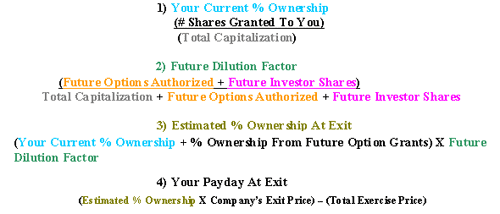 Wow. You just received a job offer from a startup which includes 50,000 stock options. That is wonderful…or is it?
Wow. You just received a job offer from a startup which includes 50,000 stock options. That is wonderful…or is it?
I reviewed and approved hundreds of Employment Offer Letters at my various startups, all of which included stock option grants. The number of otherwise intelligent prospective employees who never ask relevant questions about their stock options was frankly shocking. By getting answers to the seven questions described below, you will be able to make a reasonable estimate of what your options may ultimately be worth.
If you haven't already subscribed yet, subscribe now for
free weekly Infochachkie articles!
Options Are Just That
I am sorry to disappoint the MBA crowd, but estimating the value of your startup stock options is not something you can do using the Black-Sholes option pricing model or other Wall Street-centric approaches. In contrast, estimating the potential ultimate value of your startup options requires you to intimately understand the adVenture’s business model, the mindset of the Core Team, and the company’s five-year pro forma financial statements. Understanding these issues will help you make an informed decision regarding the viability of your next adVenture and should be performed absent any concerns you may have about your options’ value.
Math 101
In order to properly evaluate the ultimate value of your stock options, you must obtain the necessary data to solve the following four equations. At first glance, these equations may seem complicated, however; the math is actually very simple. To minimize potential confusion, the variables which are used in multiple equations are color-coded.

These formulas represent the same approach to determining a company’s ultimate value that is used by venture capitalists. Sophisticated investors start their analysis at the “end” of the transaction (the company’s exit) and then work backwards to determine how much money to invest and at what valuation, in order to achieve their desired financial return. You are investing your time and hard work and a portion of the return on your investment is what you will derive from your options. As such, act like a sophisticated investor and estimate the value of your options using this backwards approach.
Questions To Answers
Politely and persistently ask the following questions until you obtain all of the information necessary to make educated guesses for each of the variables in the above formulas.
- How many shares will I be granted?
The size of your initial option grant should be articulated in your Offer Letter, as well as in a separate Stock Option Agreement. In most cases, your shares will vest over a four-year period, with a one-year cliff. Under such an arrangement, if you leave your company within the first twelve months, for any reason, you will not vest any shares. Once you have completed your first anniversary of employment, vesting usually occurs on a monthly basis. Any vesting terms that do not conform to these standards should be challenged.
- What is the company’s total capitalization?
Be sure this answer includes all shares, options and warrants, both granted and ungranted. To help the CFO understand your request, indicate that you are seeking a “fully diluted” view of the company’s capitalization. Also, be sure that all “authorized” options are included, which will ensure that the capitalization figure includes granted and ungranted options.
- How many additional options will be authorized?
As noted in the previous question, authorized options include those which are granted as well as those which have yet to be granted. In order to estimate the extent of the future dilution you will suffer, you must estimate the number of additional options that will be authorized and added to the option pool. The size of a startup’s option pool will vary, depending on its maturation. However, the pool’s size, as a percentage of a company’s Total Capitalization, is generally between 15% and 20%. If an option pool is significantly below this range, it may be an indication of either; (i) a company that is stingy with its options, or (ii) significant future dilution may occur, once the option pool is increased to accommodate future option grants.
It is very common for companies to increase their option pool over time and a well-run company will manage a capital budget as a means of estimating its future option grants. As such, it is very reasonable to ask how many additional options are anticipated to be authorized before a company’s exit.
- How many additional shares will be issued to investors?
As is the case with the number of future options to be added to the option pool, a well-managed company will have some idea of the amount of investor capital it intends to accept in the future, along with an estimation of the valuation(s) at which such investment(s) will be made.
Future capital requirements are based on a variety of unknowable factors. However, it is imperative to understand the company’s underlying assumptions with respect to its future capital needs. A response of, “We have no idea,” is indicative of a company that is either: (i) poorly managed, or (ii) does not respect its prospective employees enough to provide them with a thoughtful response. Do not settle for a non-answer to this important question.
- How many options will I be granted in the future?
Clearly, the number of any additional options you may receive will be dependent on your ultimate tenure and the degree to which you add value to the adVenture. Many companies provide their employees with small options grants annually, usually in conjunction with either year-end or the employee’s anniversary hire date. If your prospective employer indicates that it is unlikely you will receive any future options, this is an important consideration when deciding to join a particular adVenture.
- What is Management’s best estimate of the Company’s valuation upon an exit?
If you can accurately predict this variable, you should forgo working for a living and take the first flight to Vegas. Be sure to play the lottery on your way to airport as well. For everyone else, this variable is an educated guess.
Even so, your prospective employer should be able to provide you with a valuation range in which a potential exit would be acceptable to the Core Team. One way to sanity check a potential exit value is to look at comparable companies that have recently exited.
In addition the company’s potential exit valuation, sophisticated investors also attempt to estimate the length of time to an exit. This variable is less significant to an employee, as you generally must remain with your adVenture at least four years to fully vest your initial option grant. However, you should have a basic understanding of the Core Team’s timeline to an exit.
If you depart your startup before its stock is freely tradable, you will have a limited period of time, usually 90 days, in which you must exercise your vested options. Once you exercise your options, you share the same risk as any other investor. If the company fails outright or never achieves an exit, you may own stock that is effectively worthless. As such, your expected tenure and the likely time line to the company’s exit should be approximately in sync in order for you to avoid having to exercise your options before they are freely tradable.
Asking for feedback regarding an adVenture’s potential exit valuation and timing will provide you with greater clarity as to the extent that the company may actually be a dreaded “lifestyle business.” As described in Pressure, lifestyle businesses are those in which there is no logical exit. They are often quite profitable for the Founders, but generally do not offer significant upside potential to the majority of the startup team. If you are obtaining options in a lifestyle business, your options likely have no meaningful value.
- What is the Exercise Price of my initial options?
This should also appear in your Offer Letter and Stock Option Agreement. Do not be satisfied with a response such as, “The exercise price will be defined by the Board of Directors, based on the Company’s Fair Market Value.” Ensure that your exercise price is defined in writing before you accept the position, even if it is subject to subsequent Board approval.
You can estimate the exercise price associated with any subsequent options, based on the response you received to question four.
Falling Wind
I have been fortunate to work with great teams who were able to create enough value that our options were worth a significant amount of money. However, the reality is that many startups’ options are never worth anything. As such, consider any compensation derived from your options as an unexpected windfall. Working with kind, motivated and smart people who you will learn a great deal from is a more important consideration than the size of your option grant.
The next time you are offered an option grant, do not merely say, “Wow.” Rather, politely ask your prospective employer questions that will allow you to determine what the heck the options might ultimately be worth. The questions outlined in this article will help you better understand an adVenture’s prospects of success, which will enable you to make a reality-based estimation of the potential value of your options. With a grounded understanding of a startup’s potential, you can negotiate a stock option grant that is worthy of a “Wow.”
— Get hands-on advice from your John Greathouse, Subscribe Today. —
Copyright © 2007-9 by J. Meredith Publishing. All rights reserved.




Pingback: Makers vs. Takers | infoChachkie
Pingback: Quora
Pingback: Quora
Pingback: Quora
Pingback: Quora
Pingback: Quora
Pingback: Top Ten infoChachkie Entries Of 2011
Pingback: Startups: What would be considered a good percentage of equity to receive as a mid level software developer in a company for post Series B and Series C? - Quora
Pingback: Employee Stock Options: How can I estimate the value of this options agreement? - Quora